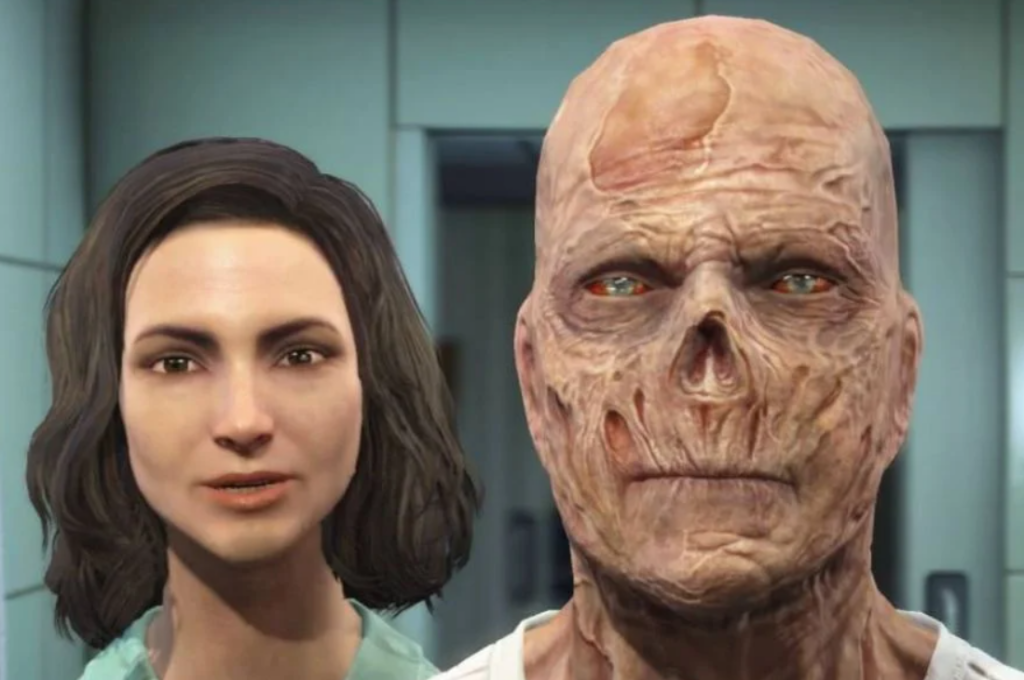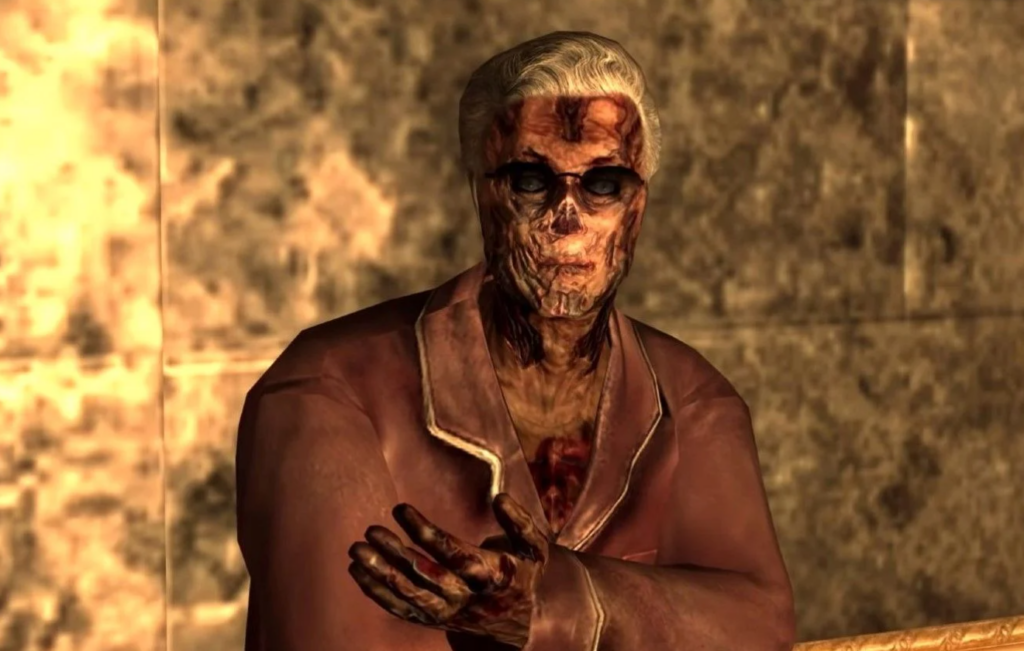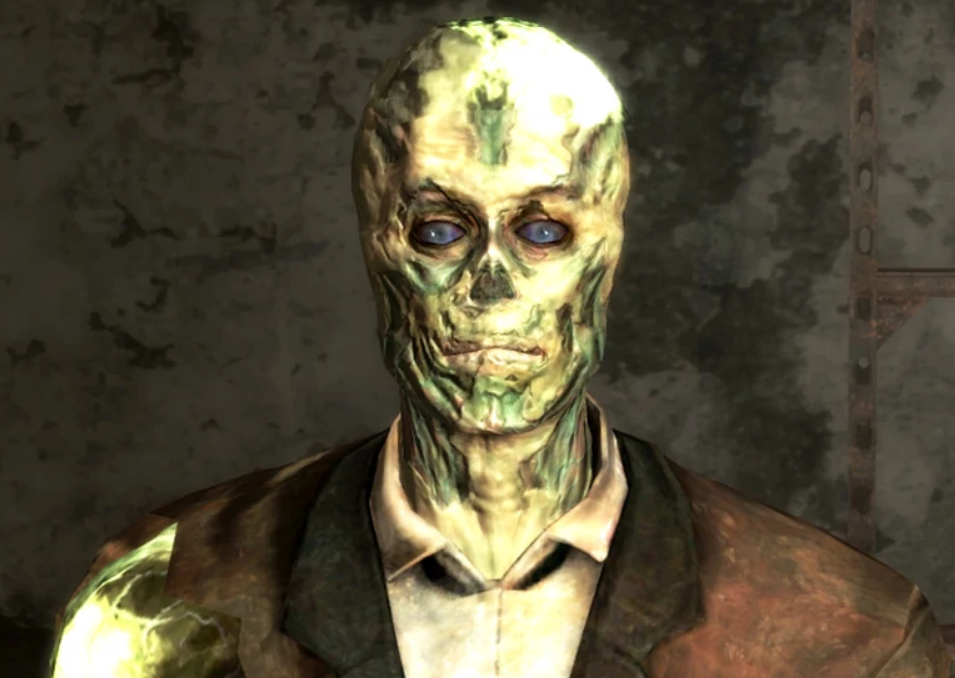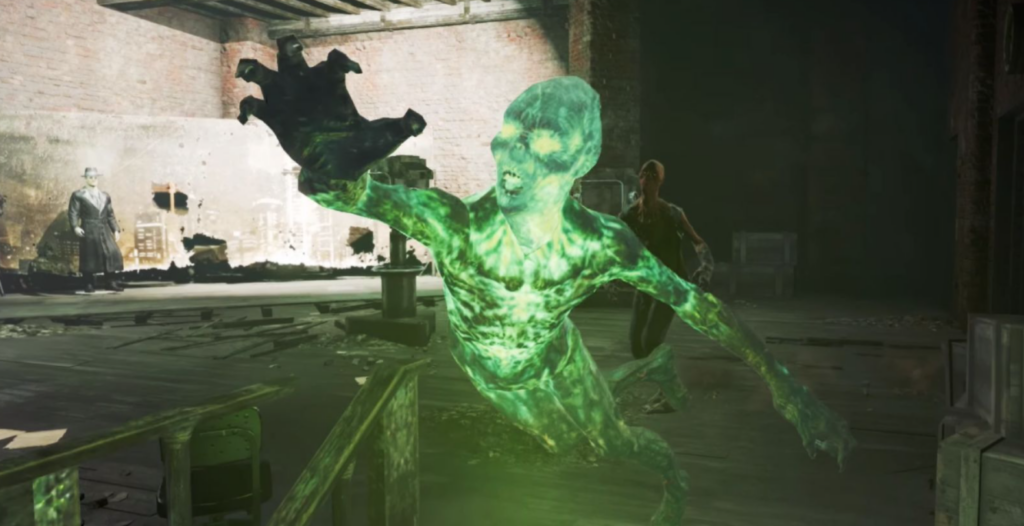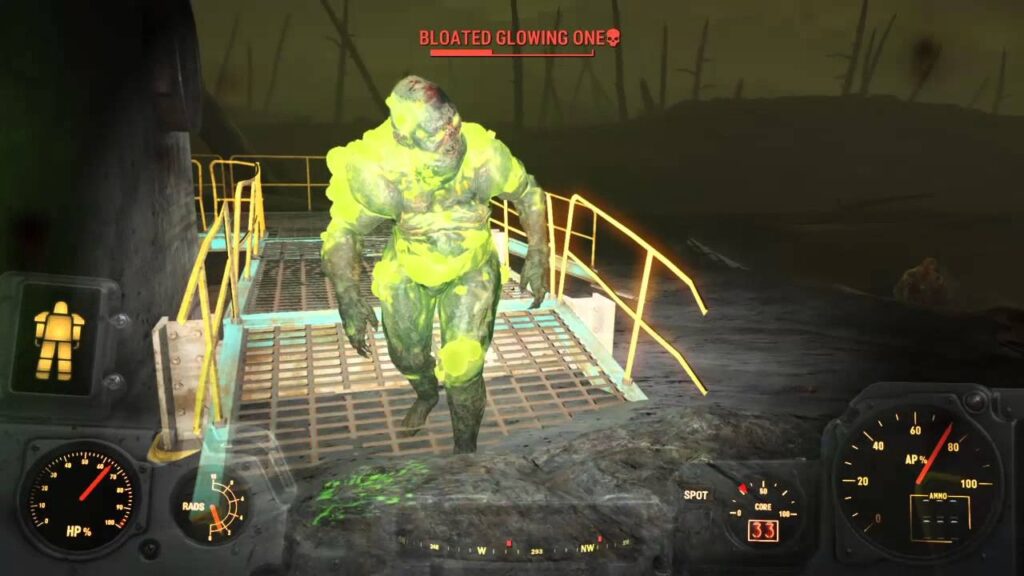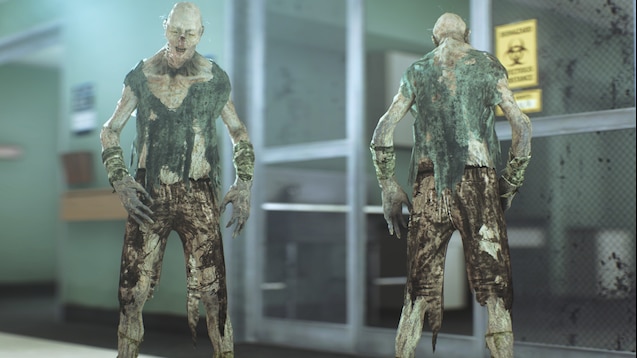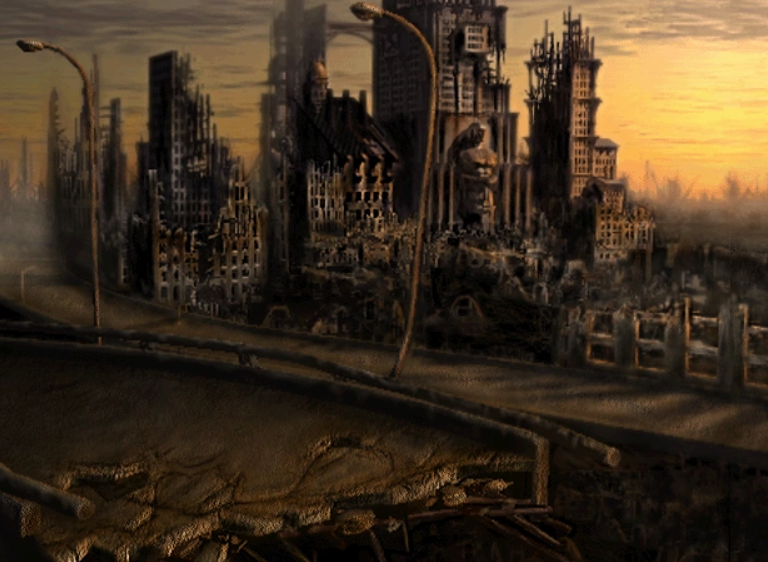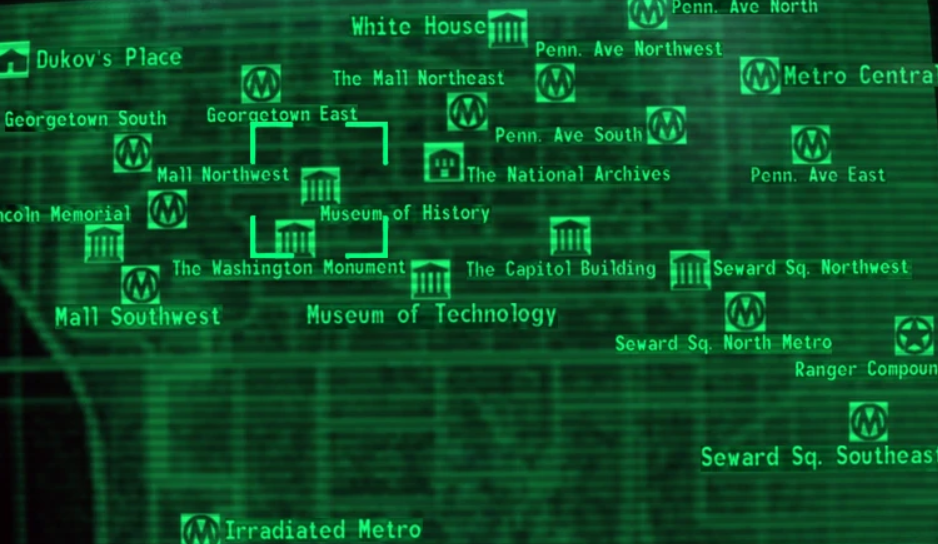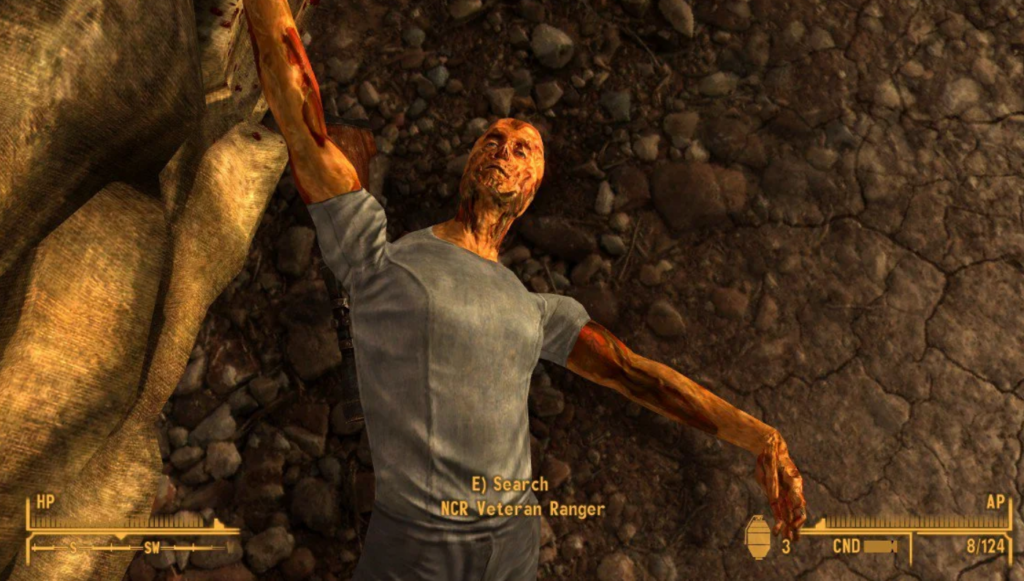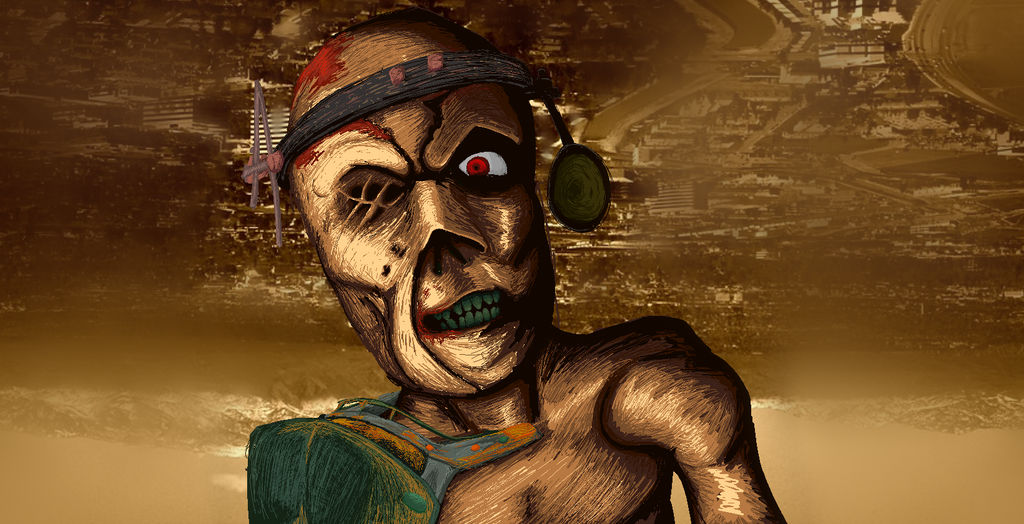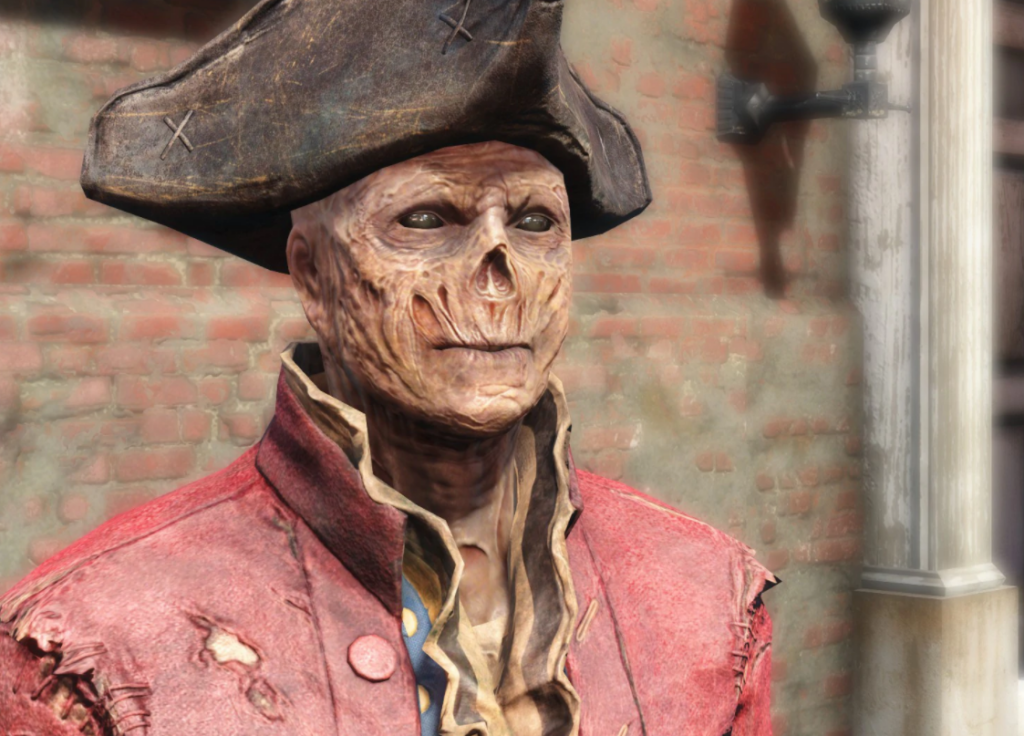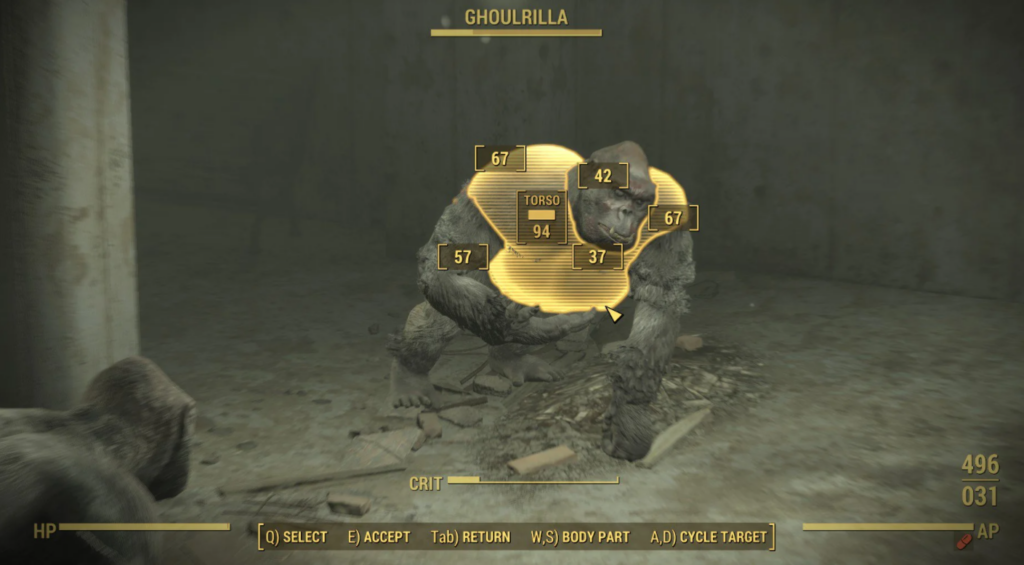- Fallout New Vegas Snow Globe Locations Guide - February 11, 2023
- Fallout New Vegas Caravan Guide: How to Play Caravan in Fallout New Vegas - January 15, 2023
- Fallout 4 DLC Guide - June 8, 2022
There are a few different races derived from humans that inhabit the Fallout universe. Super Mutants are humans that undergo FEV treatment, Centaurs are the result of that treatment gone bad. We’re not talking about mutants here, though, although that depends on who you ask. Our topic for this guide is ghouls. From regular to feral, I’ve condensed over five games worth of lore and story into a quick-reference guide to bring you all the way up to speed.
Ghouls are an integral part of any Fallout game. Not just for flavor or diversity, either. They tend to be a great story-telling device that allows the writers to highlight the discrimination and harsh, moralless people and organizations that inhabit post-war America. Different people and groups treat ghouls differently, and we can use that treatment as a baseline for who can be considered “good”, and “bad”. Although, it obviously isn’t that simple.
I’ve included everything you need to know in this Fallout ghoul guide. I’ll run you through how a ghoul is created, what life is like for them, how they turn feral, and more. Read this, and you’ll know everything you could ever possibly need to about the ghouls of the Fallout universe.
Key Details
- How a ghoul is created: Intense exposure to radiation.
- How they become feral: Deterioration of the mind.
- Ghoul abilities: Immune to aging, disease, and enhanced regenerative abilities.
General Overview/Appearance
Due to intense exposure to radiation, ghouls suffer from necrosis of the skin. As a result, their flesh is flaky and peeling, often resulting in exposed blood vessels and muscle tissue. In extreme cases, it’s possible that their internal organs can become exposed, as is the case with Set from Fallout 1.
Furthermore, this necrosis causes ghouls’ noses and ears to deteriorate and fall off, as well as their fingers in extreme circumstances. The combination of all these factors, along with the small caused by their flesh, often leads to wastelanders referring to them as zombies. This is incorrect as their flesh doesn’t actually rot, and is instead intensely burned from their radiation exposure. Therefore, this is seen as a derogatory term by the majority of ghouls.
The Origin of Ghouls
Fast Transformation Ghouls
We know that extreme exposure to radiation is what causes regular humans to mutate into ghouls. However, the rate at which that transformation takes place can vary from a few hours, to potentially a full year. While we don’t have any hard lore to reference, it seems that the severity and intensity of the exposure dictate the speed of ghoulification.
One clear example of this, and an example of post-war ghoulification, is the ghoulified NCR soldiers in Camp Searchlight from Fallout New Vegas. After Legionnaires caused a radiation leak in the camp, a garrison of NCR troopers were quickly turned not only into ghouls, but into ferals. This process was remarkably fast, especially given that they skipped the traditional ghoul phase and immediately became feral.
Another, more typical cause of rapid ghoulification is someone surviving a nuclear blast close to ground zero. The immediate heat and radiation exposure would cause the rapid decay of the body at a much more extreme rate than any gradual degradation caused by prolonged exposure.
Slow Transformation Ghouls
Slow transforming ghouls are much more varied and common than those that suffered a rapid transformation. Compared to fast transformation ghouls, the slow transformation is a lot less horrifying for the one suffering ghoulification. These ghouls generally retain both their human shape and cognition, with the degradation of the skin and necrosis being the only real noticeable difference between them and regular humans.
Most ghouls you come across in the various wastelands of Fallout suffered this fate after surviving the Great War when radiation levels were at their harshest. You’ll find numerous NPCs in different locations that can comment on the experience, such as Carol from Fallout 3’s Underworld who states “My skin started to get dry and flake off. Everyone’s did. It took a while, months, maybe a year.”
Artificial Ghouls
As well as natural fast and slow transformation ghouls, we’ve recently gotten some artificial ghouls by the way of Fallout 4’s retcons. By artificial, we’re talking about humans that intentionally turned themselves into ghouls, rather than it being a natural result of radiation exposure. There are two artificial ghouls in Fallout 4, both of which used different methods of ghoulification.
The first, and arguably more egregious of the two in terms of rewriting the lore is Hancock. This ghoul follower from Goodneighbour was originally born human long after the Great War. However, after his brother ran for mayor of Diamond City on anti-ghoul rhetoric, Hancock began to identify with ghouls and the persecution they were suffering. As a result, he sought out an experiment pre-war radiation drug that, upon taking, turned him into a ghoul. It’s unclear how the transformation happened, or how long it took.
The second example of an artificial ghoul is Eddie Winter, Nick Valentine’s nemesis. Eddie was obsessed with surviving the bombs, so much so that he began exposing himself to controlled amounts of radiation in the time leading up to the bombs dropping. This gradual, controlled exposure is not too dissimilar to slow transformation, albeit likely more forgiving as Eddie successfully ghoulified himself while retaining his hair, something that most other ghouls lose due to necrosis.
There is one more example of an artificial ghoul in Fallout 3 in the form of Desmond Lockheart. Desmond was a pre-war member of British Intelligence who, like Eddie, was exposed to controlled levels of radiation resulting in his ghoulification.
Born Ghouls
There are no born ghouls in Fallout canon. I’m including this as a footnote to ghoul origins as it was a planned inclusion for the canceled Fallout Van Buren. That game was meant to introduce a group of scientists who, thanks to experimentation on fetuses, managed to have a baby born already ghoulified. It’s unclear how this would have affected the Fallout universe’s greater lore, especially as ghouls can’t age. However, given that Van Buren never saw the light of day, we don’t need to worry about that.
Ghoul Traits and Abilities
Immunity to Disease
Due to changes in a ghoul’s anatomy, namely their metabolism and digestive tract, they’re able to sustain themselves on food that would be considered inedible by normal human standards. As a follow-up result of this, they are also more immune to natural, physical diseases than humans. However, they are still vulnerable to diseases associated with the degradation of tissue such as dementia and arthritis.
An example of this can be seen in Fallout New Vegas’ Harland, who sustained himself on Radroach meat and water condensation from pipes for far longer than would be possible for a regular human.
Immunity to Chems
The lore on this one is a little bit iffy.
In Fallout 3, you can come across a ghoul chemist named Murphy. Murphy is developing an enhanced version of Jet, named Ultrajet, that ghouls can use. His motive for this is that ghouls have an immunity to the high provided by normal Jet. This would make sense given the metabolic changes that we know ghouls undertake.
However, there is a ghoul named Snowflake in Underworld who gets high on Jet regularly, as does Hancock from Fallout 4. It’s unknown if these two share a sensitivity to Jet that other Ghouls don’t, or if Murphy is wrong about ghoul immunity to chems.
Regenerative Qualities
Like with ghoul immunity to chems, the lore on one’s regenerative qualities is different depending on the source, and writer.
For example, we have ghouls that claim they need water and food to survive, such as the aforementioned Harland and ghouls from Necropolis in Fallout 1. Then, on the other hand, there are NPCs like Coffin Willie who, thanks to the natural regenerative qualities of a ghoul’s body, is able to remain alive despite the prolonged absence of water, food, and even oxygen.
There is also Billy Peabody from Fallout 4 who is in the same boat. However, that particular character is such an egregious slap in the face of Fallout lore that even Bethesda refuses to comment on it, so I think we can chalk him up as a non-canon easter egg.
So, we’re unsure about whether a ghoul’s regenerative ability allows them to survive without sustenance. However, we do know that it allows them to regain their use of re-attached limbs.
Patchwork from Underworld is a clear example of this. Due to the necrosis that all ghouls suffer, Patchwork’s limbs keep falling off. However, he retains the use of them each time Dr. Barrows reattaches them.
Necrosis
This is the clearest and most noticeable trait that separates ghouls from humans. It’s the cause for the zombie-like appearance that ghouls take on, the corpse-like smell associated with them, and the reason they are discriminated against by the majority of wastelanders.
Despite ghouls being immortal in theory and ceasing to age, their body, due to radiation exposure, suffers tissue degradation. Their skin will die and flake, resulting in hair loss, exposed muscle, the loss of nose and ear tissue, and exposed blood vessels. This degradation also affects the larynx, resulting in the raspy voices that we associate with most ghouls, excluding artificial ones like Hancock.
Sterility
Despite the retention of their sex drive, ghouls are entirely sterile. Given the effects of radiation exposure, this makes complete sense and is unlikely to be changed in the lore. Even when there was talk of born ghouls in Van Buren, it was the result of experimentation rather than a pregnant ghoul.
Halts Aging
Being turned into a ghoul halts the aging process at whatever age the person was before undergoing ghoulification. Because of this, ghouls are technically immortal.
This, combined with ghoul necrosis, leads people to believe that a ghoul’s rotting flesh is the result of age and decomposition. This is incorrect. The necrosis is actually a direct result of exposure to harsh radiation.
Vulnerability to Degradation/Dementia
While a ghoul’s metabolism affords them a natural resistance to a lot of diseases, the necrosis they suffer makes them most susceptible to others. The most notable of these are conditions like arthritis and cataracts. However, dementia is a far more dangerous concern for ghouls. While those that live in communities tend to not suffer from dementia, there are ghouls that become afflicted by it.
Primarily, being isolated from civilized society causes its development. This is a problem as it leads to feralization as one forgets who they are, turning them into a feral ghoul that will attack on sight.
Transformation to Feral Ghouls
Feral Ghouls
As mentioned, the transformation from ghoul to feral ghoul can be a long and painstaking process caused by the onset of dementia. If a ghoul is isolated long enough, they will eventually lose their mind and cognition, turning them into an empty killing machine. There are a few rare examples of non-hostile ferals, like Ethyl and Meat from Underworld. With that, it’s worth noting that ferals are not hostile against regular ghouls.
While some feral ghouls are the result of prolonged exposure and degradation of the mind, others are created by sudden, intense radiation exposure. The combined shock, trauma, and radioactive side effects effectively cause insanity, resulting in immediate feralization rather than the creation of a conventional ghoul.
Again, this is what happened in New Vegas’ Camp Searchlight. The NCR troopers affected did not have any time to process the Legion attack, resulting in the immediate jump from human to feral.
Glowing Ones
Glowing ones are the next step in the degradation of ghouls. While the vast majority of glowing ones are ferals, there are a handful of cognisant glowing ones such as Jason Bright.
A glowing one is caused by a unique condition where a ghoul’s body stops filtering radioactive particles from their bloodstream. As a result, their blood begins to dilute with these particles, causing their distinctive glow.
Ghoul Cities
Necropolis – Fallout 1
Necropolis is a ghoul city from Fallout 1. Necropolis was built on top of Vault 12. This vault’s experiment was to study the effects of prolonged radiation exposure on its residents. While the vault was designed to work as intended, its door was not. So, when the vaults closed and the bombs fell, the door to Vault 12 was left slightly ajar, resulting in the vault flooding in radiation.
Those who survived this process underwent the ghoulification process, left the vault, and eventually founded Necropolis.
Following the Vault Dweller’s visit to Necropolis, Super Mutants raided the city in a reprisal attack. Most of the ghouls inhabiting Necropolis fleed. Those that stayed were massacred.
Gecko – Fallout 2
Gecko is a town found in Fallout 2 run by Harold. It’s a settlement built around a half-functional Posiden nuclear power plant.
Given that ghouls were shunned by other settlements in the Southwest, it was only natural that they would begin to congregate around the old power plant. Prospectors and scavengers avoided it for fear of radiation exposure, so it made for a perfect ghoul-centric settlement.
Underworld – Fallout 3
Underworld is a ghoul settlement located in the Museum of History in the Capital Wasteland. The settlement is split into two sections: one inhabited by regular ghouls that while wary, are welcoming to outsiders, and a side completely inhabited by ferals.
Elder Lyon’s Brotherhood of Steel was hostile against the ghouls of Underworld and would fire on them on sight. However, they never ventured into Underworld to exterminate them. The ghouls resented them for this, as well as for turning the area around Underworld into a Super Mutant warzone.
It’s unclear whether or not Underworld survived Elder Maxson’s rise to power.
Discrimination Against Ghouls
Discrimination against ghouls ranges from location to location, and group to group. While some organizations and cultures are welcoming of them, others view them as abominations that should be exterminated.
General Wastelanders
Regardless of where you are in post-war America, regular wastelanders tend to be very harsh on ghouls. While not all share the anti-ghoul sentiment, most do, resulting in the isolationism that created Necropolis, Underworld, and Gecko.
This harsh treatment can be seen on any rare occasion a ghoul finds themselves inhabiting a regular settlement, as is the case with Gob in Megaton.
This is also evident in Fallout 4’s Diamond City. The city was once welcoming to ghouls, but after Mayor McDonough’s anti-ghoul campaign, its residents turned on them, forcing a mass exodus to Good Neighbour.
NCR
The NCR, in general, is quite welcoming to ghouls. While the sentiment of individuals in the NCR may vary, the organization itself treats them as equals, so much so ghouls are actively recruited into its military. Granted, that may be out of necessity rather than egalitarianism.
This two-faced approach to ghoul integration can be seen in the New Vegas Strip’s policy on not permitting ghouls entry unless they are accompanied by a non-ghoul, despite ghouls working as prostitutes in the Gomorrah Casino. It’s unclear whether this is an NCR policy, or a Mr. House policy, however.
Brotherhood of Steel
The attitude of the Brotherhood of Steel towards ghouls varies between chapters.
For example, the Midwestern chapter is known to not only tolerate but actively accept ghouls into its ranks. However, this is an extremity not shared by most other BoS outfits.
Even Elder Lyon’s Brotherhood, which was seen as far more morally good than the rest of the organization, would open fire on ghouls regularly.
While the Brotherhood isn’t as fanatical about exterminating ghouls as the Enclave is, they do tend to view them as abominations that should be executed.
Important Ghouls in Fallout
Set
Set was the leader of Necropolis when the Vault Dweller visited in 2161. He was originally a resident in Vault 12 with his son. After the bombs fell, both of them were turned into ghouls.
As the leader of Necropolis, Set acts as a figurehead for the Master. He is charged with keeping the ghouls in line and watching for humans. Despite this, Set held deep resentment towards the Master.
Set died during the Super Mutant assault on Necropolis.
Harold
Harold is the only character, to my knowledge, to be present in Fallout 1, 2, and 3. He was once a human caravan master, before undergoing an FEV treatment at the hand of the Master that turned him into a ghoul.
After his transformation, he spent a period of time living in Gecko. Following that, his mutation worsened and he eventually became a tree diety for the Treeminders in the Capital Wasteland.
Gob
Gob is likely the first ghoul that the majority of Fallout fans encountered. He can be found in Megaton, tending to Moriarty’s Saloon. While technically a free man, he is practically enslaved by Colin Moriarity and has been for 15 years.
Gob’s only known family is Carol in Underworld. Carol acts as Gob’s adopted mother and will react as such whenever you bring her news about her “son”.
Hancock
Hancock, or John McDonough, is the mayor of Goodneighbour, brother of Diamond City’s Mayor McDonough, and the only person ghoulified by a pre-war experimental drug. He is also a potential follower for the player in Fallout 4.
Hancock is amongst a very small group of people that willingly turned themselves into a ghoul. The details of his transformation, as well as the drug that caused it, are unknown.
Jason Bright
Jason Bright is the leader of a cult of ghouls that occupy the Repconn Test Site in Fallout New Vegas. He is a friendly Glowing One and leads the Bright Brotherhood. His brotherhood wants to undertake a great journey to escape the bigotry and hardship of the wasteland.
The outcome of Jason Bright and the Bright Brotherhood is determined by the Courier in the quest Come Fly With Me.
Non-Humanoid Ghouls
Humans are not the only organisms that can be ghoulified by exposure to radiation. Many animal species have also undergone transformations since the bombs fell, with more getting added to the existing lore with the release of each new Fallout game.
Ghoulrilla
The Ghoulrilla made its first appearance in Fallout 4’s Nuka World DLC. They are friendly in that DLC, but it’s unknown whether or not they would attack out in the wild. Compared to other animals, the ghoulification process that gorillas have undergone has been minor, with almost all of their original features being fully maintained.
Yao Gui
The Yao Gui is perhaps the most extreme example of an animal being ghoulified. These terrifying creatures were once regular bears. Thanks to exposure to radiation, they have increased muscle mass, resulting in higher levels of strength, speed, and aggression.
Other Non-Humanoid Ghouls:
There are a few other species of animals that we know have undergone radiation transformation including:
- Beavers
- Whales
- Dogs
- Rabbits
- Deer
- Cows
- Seagull
- Rats
- Sheep
- Squirrels
- Wolves
FAQ
Question: How long do ghouls live in Fallout?
Answer: Ghoulification halts the aging process in Fallout. Therefore, all ghouls are technically immortal. Provided they don’t succumb to the elements or a bullet, they can live forever.
Question: Do all ghouls turn feral?
Answer: No. Ghouls that are able to integrate into a community are capable of maintaining their humanity and not turning feral. Becoming feral is not an inherent, natural part of a ghoul’s life.
Question: Can ghouls have babies in Fallout?
Answer: No. The intense radiation needed to create a ghoul renders a ghoul sterile, although they do maintain their libido.
Conclusion
Okay, that’s as much as I have for you with this Fallout ghoul guide. I’ve tried to be as comprehensive as possible without boring you to death, so I hope I managed to succeed in that endeavor. With how much material we have on ghouls, you could write a book about them. I’ve condensed all of that down into only the important stuff, so read this and you’ll know as much as any other Fallout lore aficionado.


